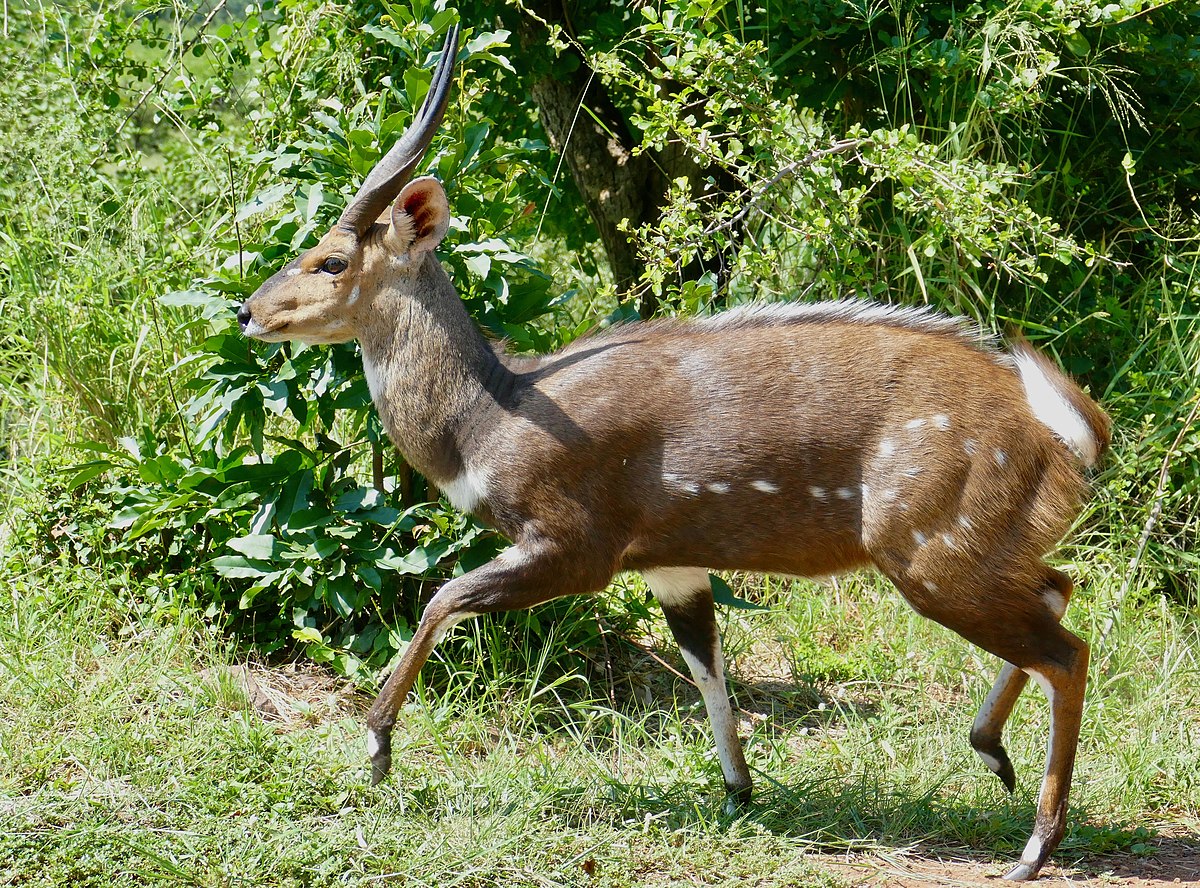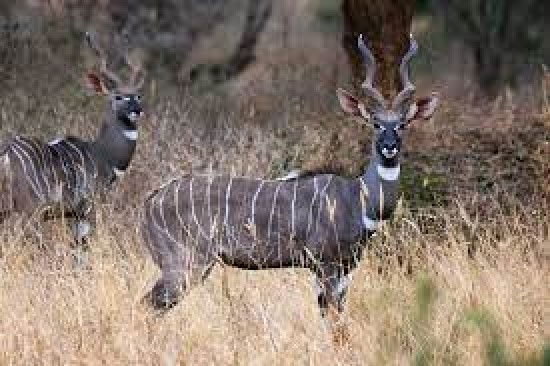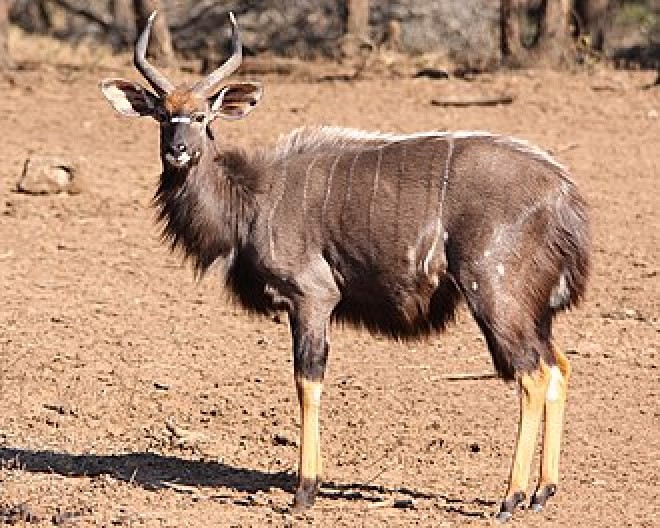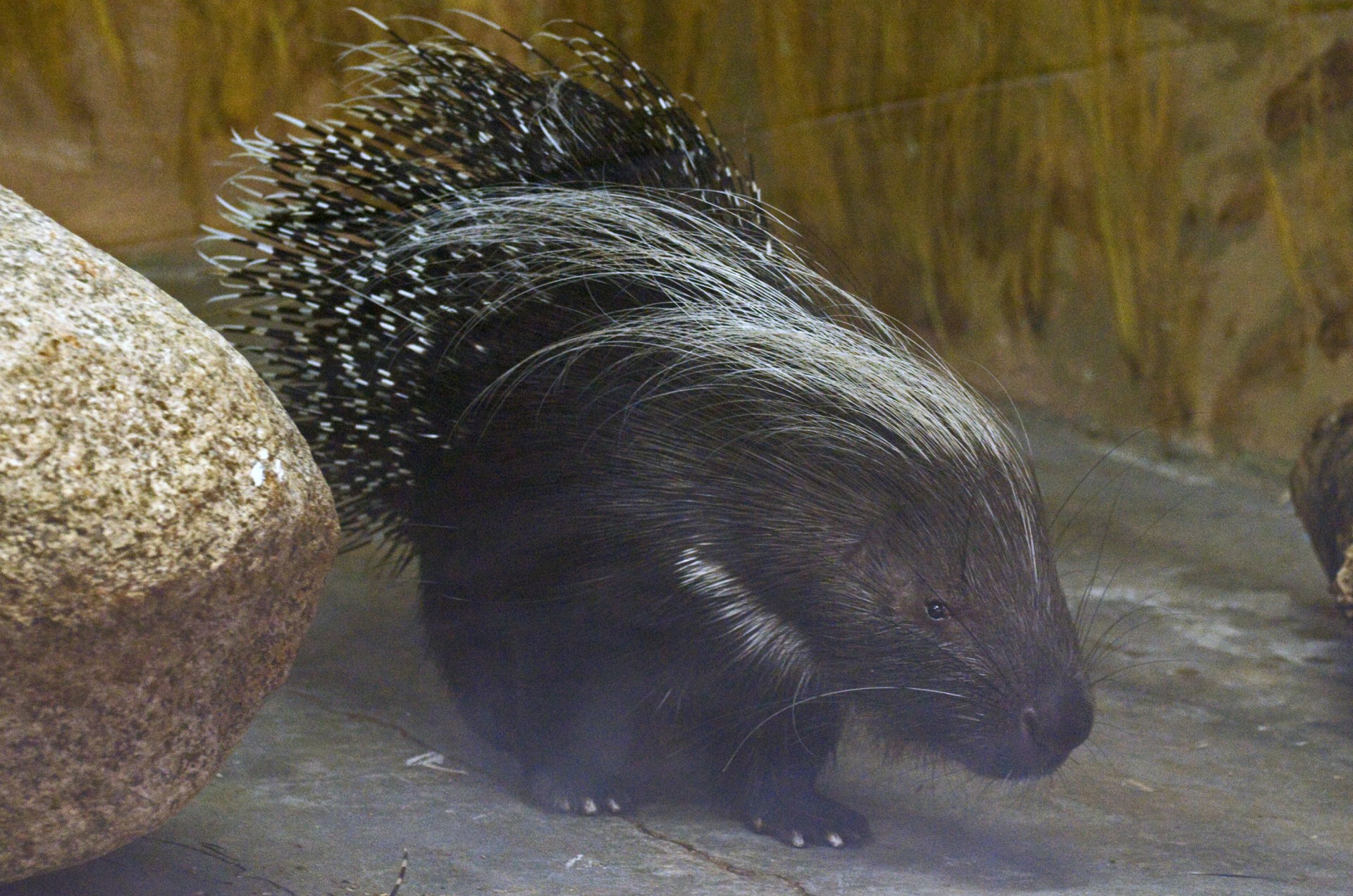The Pantanal is an incredibly wilderness, however, the Paraguay river is planned to be turned into a water way and build ports. I have included 2 videos for you to look at (depending on how much time you have). The video above is around 4 minutes, while the below is a full documentary 50 minutes.
Continue reading “Plans to turn the Pantanal into a waterway, will destroy this wilderness”Cao Vit gibbon
Cao Vit gibbon
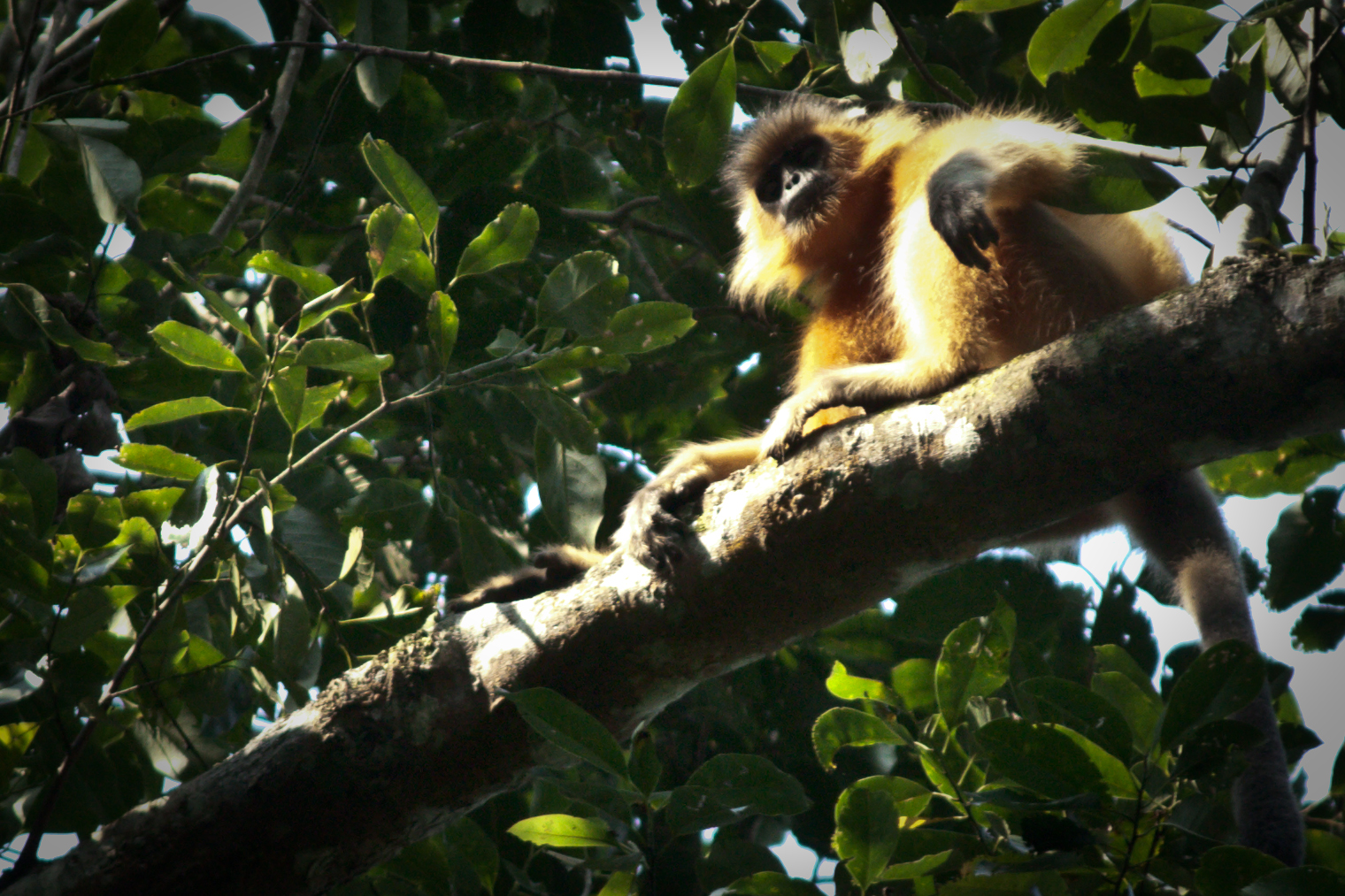
The Cao Vit gibbon is a species found on the border of Vietnam and China. Only thought to number 74 in the wild (and having suffered a loss of 38% of the population in recent years, this is a little known and critically endangered species. Once thought to be a subspecies of the Hainan black crested gibbon, it was found to be far to distinct for this.
Its name is an attempt at mimicking its name.
While in the past it has been hunted, and could be the reason that the population is so low, its biggest threats at the current time, include loss of habitat, and habitat degradation for firewood.
Any articles on this species will appear below.
We also hope to add places for you to see this species in the wild as soon as possible.
Spade-toothed whale washes ashore in New Zealand

The Beaked whales are very hard to see, as they hold the record for length of time holding breath, with some having approached the 2 hour period.
As such, this family of whales are generally only seen occasionally. Assuming 10 minutes at the surface after each dive, you are talking about 2 hours every 24, and they also have very low profiles in the water.
As a result, dead animals washing up on shore from these species give a rare incite into this rarely seen family.
In this instance, one has washed ashore in New Zealand. The last sighting was in 2012, when a mother and calf washed ashore, but this was the first sighting for 150 years. It should be noted, that this species was described from a whale jaw-bone, as one would think, it is hard to describe something that is seen so rarely.
This animal has never been sighted alive. We have no idea if it is on the edge of extinction, or whether there are many of them, swimming deep in the worlds oceans. Below is a news article on this species, where you can see a video of the removal and an image or two.
1. Tragelaphini – spiral-horned antelope
1. Tragelaphini - spiral-horned antelope
Bushbuck
The Cape bushbuck , also known as imbabala is a common, medium-sized and a widespread species of antelope in sub-Saharan Africa. It is found in a wide range of habitats, such as rain forests, montane forests, forest-savanna mosaic, savanna, bushveld, and woodland. Its stands around 90 cm at the shoulder and weigh from 45 to 80 kg. They are generally solitary, territorial browsers.
known as imbabala is a common, medium-sized and a widespread species of antelope in sub-Saharan Africa. It is found in a wide range of habitats, such as rain forests, montane forests, forest-savanna mosaic, savanna, bushveld, and woodland. Its stands around 90 cm at the shoulder and weigh from 45 to 80 kg. They are generally solitary, territorial browsers.
Although rarely seen, as it spends most of its time deep in the thick bush, there are around 1 million in Africa
Common Eland
 The common eland (southern eland or eland antelope) is a large-sized savannah and plains antelope from East and Southern Africa. An adult male is around 1.6 m tall at the shoulder (females are 20 cm shorter) and can weigh up to 942 kg with a typical range of 500–600 kg. Only the giant eland is (on average bigger). It was described by Peter Simon Pallas in 1766. Population of 136,000, can form herds of 500
The common eland (southern eland or eland antelope) is a large-sized savannah and plains antelope from East and Southern Africa. An adult male is around 1.6 m tall at the shoulder (females are 20 cm shorter) and can weigh up to 942 kg with a typical range of 500–600 kg. Only the giant eland is (on average bigger). It was described by Peter Simon Pallas in 1766. Population of 136,000, can form herds of 500
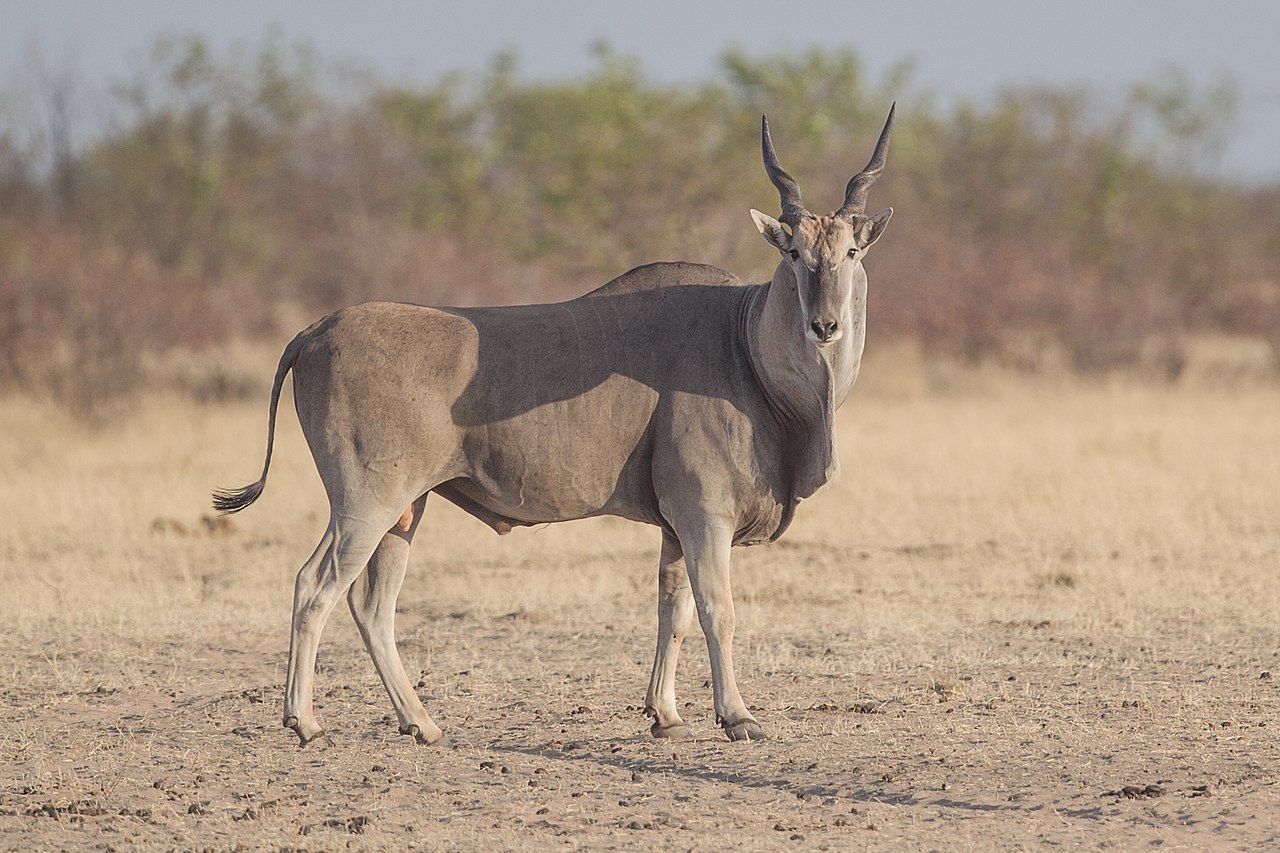
Giant Eland
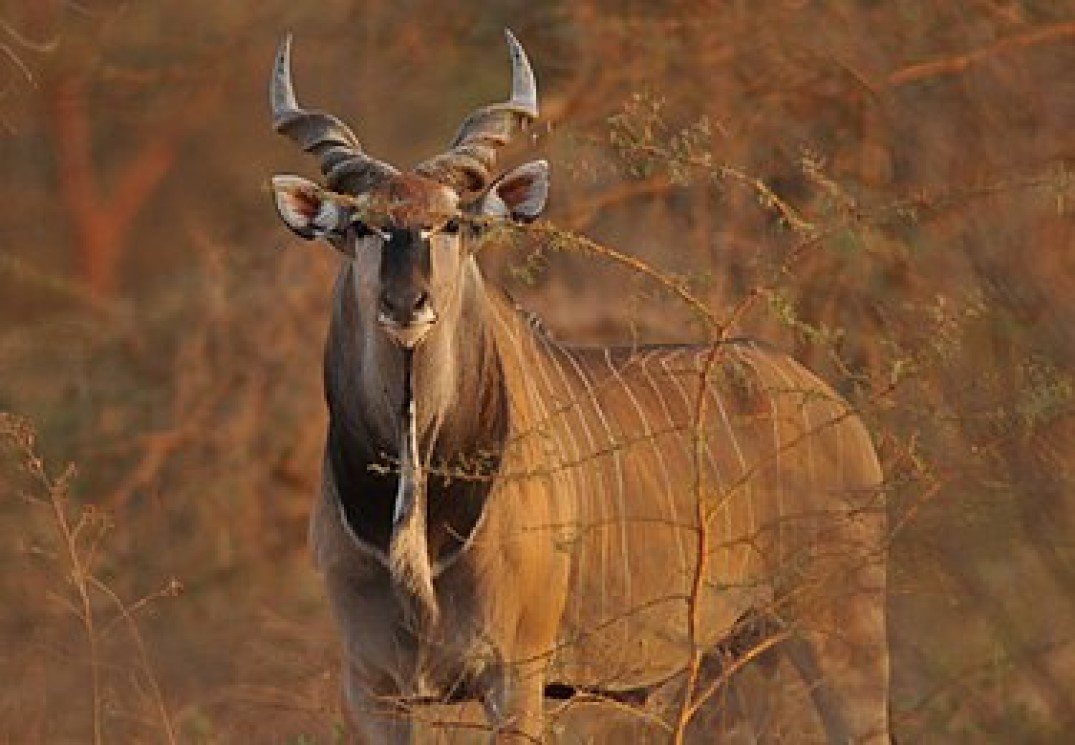
The giant eland, (also known as Lord Derby’s eland and greater eland) is an open-forest and savanna antelope.

It was described in 1847 by John Edward Gray. The giant eland is the largest species of antelope, with a body length ranging from 220–290 cm (87–114 in). There are two subspecies: T. d. derbianus and T. d. gigas.
The giant eland is a herbivore, living in small mixed gender herds consisting of 15–25 members. Giant elands have large home ranges. They can run at up to 70 km/h. They mostly inhabit broad-leafed savannas and woodlands and are listed as vulnerable and have a wild population of 12,000-14,000
Greater Kudu
 The greater kudu is a large woodland antelope, you can see its distribution on the map. Despite occupying such widespread territory, they are sparsely populated in most areas due to declining habitat, deforestation, and poaching.
The greater kudu is a large woodland antelope, you can see its distribution on the map. Despite occupying such widespread territory, they are sparsely populated in most areas due to declining habitat, deforestation, and poaching.
The spiral horns are impressive, and grow at one curl every 3 years – they are fully grown at 7 and a half years with 2 and a half turns. Three subspecies have been agreed (one described has been rejected) :
- T. s. strepsiceros – southern parts of the range from southern Kenya to Namibia, Botswana, and South Africa
- T. s. chora – northeastern Africa from northern Kenya through Ethiopia to eastern Sudan, Somalia, and Eritrea
- T. s. cottoni – Chad and western Sudan
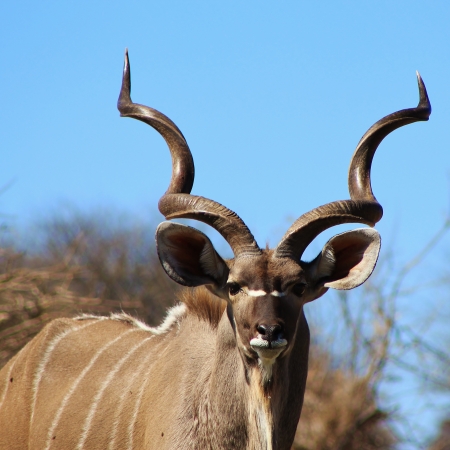
Lesser Kudu
The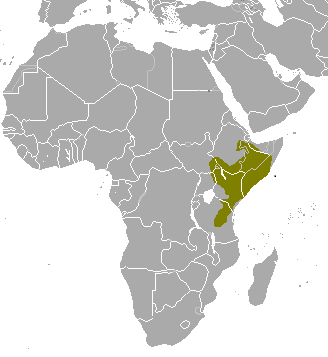 lesser kudu is a medium-sized bushland antelope found in East Africa. It was first scientifically described by English zoologist Edward Blyth (1869).It stands around 90 cm at the shoulder and weigh from 45 to 80 kg. They are generally solitary, territorial browsers.
lesser kudu is a medium-sized bushland antelope found in East Africa. It was first scientifically described by English zoologist Edward Blyth (1869).It stands around 90 cm at the shoulder and weigh from 45 to 80 kg. They are generally solitary, territorial browsers.
While currently rated not threatened, its population is decreasing. It currently stands at 100,000, but it is loosing territory to humans
Common Bongo (and mountain Bongo)
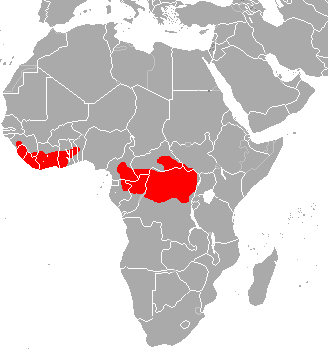 The bongo is a large, mostly nocturnal, forest-dwelling antelope, native to sub-Saharan Africa. Bongos are characterised by a striking reddish-brown coat, black and white markings, white-yellow stripes, and long slightly spiralled horns. It is the only member of its family in which both sexes have horns. Bongos have a complex social interaction and are found in African dense forest mosaics. They are the third-largest antelope in the world.
The bongo is a large, mostly nocturnal, forest-dwelling antelope, native to sub-Saharan Africa. Bongos are characterised by a striking reddish-brown coat, black and white markings, white-yellow stripes, and long slightly spiralled horns. It is the only member of its family in which both sexes have horns. Bongos have a complex social interaction and are found in African dense forest mosaics. They are the third-largest antelope in the world.
The Common (western or lowland bongo), faces an ongoing population decline, and the IUCN considers it to be Near Threatened.
The mountain bongo (or eastern) of Kenya, has a coat even more vibrant than the common version. The mountain bongo is only found in the wild in a few mountain regions of central Kenya. This bongo is classified by the IUCN as Critically Endangered (where it breeds readily). (this is not on the map above). Only 100 live wild, split between 4 areas of Kenya
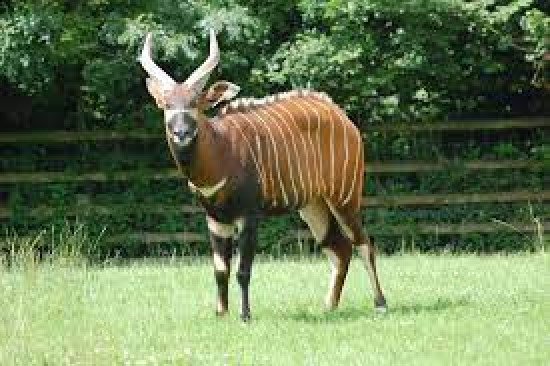
Nyala
The Nyala is a spiral horned species
found in Southern Africa. The nyala is mainly active in the early morning and the late afternoon. It generally browses during the day if temperatures are 20–30 °C and during the night in the rainy season. The nyala feeds upon foliage, fruits and grasses, and requires sufficient fresh water. It is a very shy animal, and prefers water holes to the river bank. Not territorial, they are very cautious creatures. They live in single-sex or mixed family groups of up to 10 individuals, but old males live alone. They inhabit thickets within dense and dry savanna woodlands. The main predators of the nyala are lion, leopard and African wild dog, while baboons and raptorial birds prey on juveniles. Males and females are sexually mature at 18 and 11–12 months of age respectively, though they are socially immature until five years old. They have one calf after 7 months of gestation. Its population is stable, with the greatest threat coming from habitat loss as humans expand. There are thought to be 36500 and the population is stable.
Mountain Nyala
The mountain Nyala ( also known as the Balbok) is a large antelope found in high altitude woodlands in just a small part of central Ethiopia. The coat is grey to brown, marked with two to five poorly defined white strips extending from the back to the underside, and a row of six to ten white spots. White markings are present on the face, throat and legs as well. Males have a short dark erect crest, about 10 cm (3.9 in) high, running along the middle of the back. Only males possess horns.
also known as the Balbok) is a large antelope found in high altitude woodlands in just a small part of central Ethiopia. The coat is grey to brown, marked with two to five poorly defined white strips extending from the back to the underside, and a row of six to ten white spots. White markings are present on the face, throat and legs as well. Males have a short dark erect crest, about 10 cm (3.9 in) high, running along the middle of the back. Only males possess horns.
The mountain nyala are shy and elusive towards human beings. They form small temporary herds. Males are not territorial. Primarily a browser. They will grazing occasionally. Males and females are sexually mature at 2 years old.. Gestation lasts for eight to nine months, after which a single calf is born. The lifespan of a mountain nyala is around 15 to 20 years.
Found in mountain woodland -between 3000m and 4000m. Human settlement and large livestock population have forced the animal to occupy heath forests at an altitude of above 3,400 m (11,200 ft). Mountain nyala are endemic to the Ethiopian highlands east of the Rift Valley. As much as half of the population live within 200 square km (77 sq mi) area of Gaysay, in the northern part of the Bale Mountains National Park. The mountain nyala has been classified under the Endangered category of the (IUCN). Their influence on Ethiopian culture is notable, with the mountain nyala being featured on the obverse of Ethiopian ten cents coins.
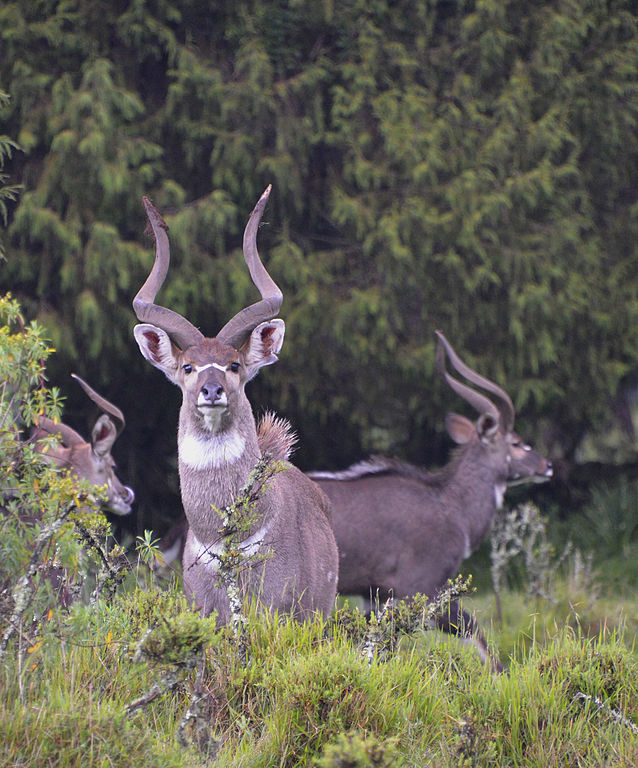
Situnga Antelope

The sitatunga (or marshbuck)is a  swamp-dwelling medium-sized antelope found throughout central Africa (see the map to the right. The sitatunga is mostly confined to swampy and marshy habitats. Here they occur in tall and dense vegetation as well as seasonal swamps, marshy clearings in forests, riparian thickets and mangrove swamps.
swamp-dwelling medium-sized antelope found throughout central Africa (see the map to the right. The sitatunga is mostly confined to swampy and marshy habitats. Here they occur in tall and dense vegetation as well as seasonal swamps, marshy clearings in forests, riparian thickets and mangrove swamps.
The scientific name of the sitatunga is Tragelaphus spekii. The species was first described by the English explorer John Hanning Speke in 1863.
It is listed as least concern with 170,000-200,000, and are found in 25 countries. However 40% live outside reserves, so the situation could get worse fast.
Note: these animals have been dealt with in less detail than others. Should you be interested in finding out if I have written on these animals or what exactly I said, you can find a list of articles about each below its information.
Golden Jackal found in France for the first time
Golden jackals are not native to France, probably as a result of of the presence of wolves. Unfortunately, wolf populations have dropped so low, that their presence is not stopping the spread of animals like this.
In this instance, the female was too young to have arrived on its own, suggesting that not only are golden jackals present, but they are breeding.
We will have to watch this space, and see what is happening. Will the recovering wolf population stop the spread, or are golden jackals going to become a permanent part of west Europe’s fauna?
To read more about golden jackals visit our golden jackal page here
Albino panda spotted in the wild
If anyone has been reading this blog for some time, you may remember me writing about an albino panda that was photographed in wulong nature reserve in China (click here to read it)
This bear has been caught on camera (see above) and appears to be doing well. It has started to display mating behaviour and appears to be extremely healthy. It has all the features generally associated with albinism, with white fur and red eyes.. It is now around 5-6 years old, and has been seen playing with other pandas, suggesting that its unusual colouring is not leading to it being shunned from other pandas.
It was filmed approaching a mother with a 2 year-old cub. As the mother was ready to mate again, and yet did not show aggression to this male bear getting close, it is likely that this female is the mother of the white cub.
Currently thought to be numbered 1800 in the wild, the panda is currently listed as threatened – having been delisted from being endangered in 2016. It is also an integral part of the Giant panda national park which is being created, and links 67 panda reserves, allowing the bears to travel between the former islands of habitat, giving them the ability to breed in a more natural way. This is important, as inbreeding would make panda conservation even harder.
Red panda
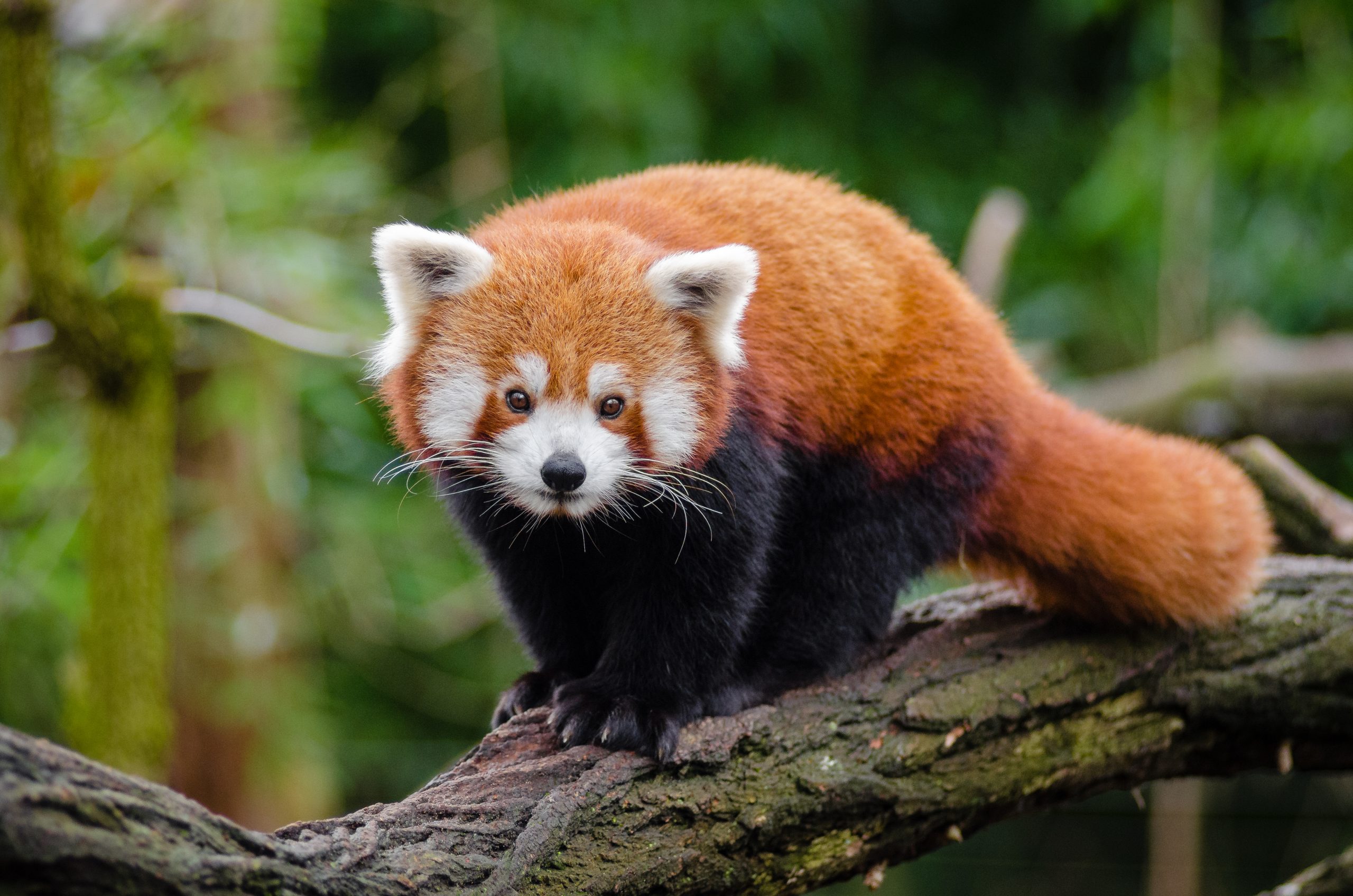
Red Panda
Recent genetic analysis has shown that the red panda is not in fact a small bear, but instead has a closer relationship to raccoons, mustelids (badgers otters and the like) and skunks. However, what is even more fascinating, is that the next closest related family is in fact the pinipeds (seals sealions and similar) and only after this, do we find the giant panda amongst the other bears.
What is fascinating, though, is that this is the original panda. The red panda was discovered and named in 1825, while the giant panda was only discovered in 1869. I cannot find any articles on it, but I suspect that the red panda was also long-known about in China before its discovery as well.
It is not closely related to the giant panda, which is a bear, though they do share a number of features such as elongated wrist bones or “false thumbs” used for grasping bamboo (so-called convergent evolution; where distantly related species evolve the same features, because it allows each to survive well in the wild – eating what they eat (or similar). The evolutionary lineage of the red panda (Ailuridae) goes back as far as 18-25 million years ago, and there are a variety of fossils in this lineage, found in Europe and North America.
So what has happened in recent times? They were known to be found in two different places, one of them lives in the Himalayas and the other in China. What has been discovered in recent times, is that these are not only subspecies, but separate species – and are thought to have split 250,000 years ago. However, while this is clearly true, it may well need to be forgotten – there are only 10,000 red pandas left in the wild as the top possible estimate, some suggest that there are actually only 2500 – we may have no choice in conserving both species, but have to interbreed them to help just one mixed group of red pandas, rather than loosing all red pandas from the wild. They live in coniferous forests as well as temperate broadleaf and mixed forests, favouring steep slopes with dense bamboo cover close to water sources. Most of its nutrients come from bamboo stems and leaves,
Support for these wild populations is essential. The best way to help justify their long term survival, is for local people to see them as a financial gift. This can happen quickly, with not that many people going there.
Below is a video for each, below that is a list of any articles which mention this fascinating creature, and below that, we will add any links that will help you see these animals in the wild.
Porcupine
The porcupine family is a highly varied thing. There are a total of 11 species of old world porcupines (Africa and Asia and Europe) and a total of 20 species in the Americas (new world)
Firstly the old world Porcupines: Family Hystricidae
African brush-tail porcupine
 This is a species of rat-like porcupine, found in a broad belt of Equatorial Africa, right across the continent from Guinea to Kenya.
This is a species of rat-like porcupine, found in a broad belt of Equatorial Africa, right across the continent from Guinea to Kenya.
40-50cm long and weighing 3kg, with short legs and long body, it does look like a very large rat (without a long tail). It has webbed feet, and light small quills, which are thinner and more like a brush on the tail. It makes a rattling noise when it moves.
Living in family groups of around 8 (they are not territorial and will share ranges with other groups) they defend themselves, like other porcupines by charging backwards. They are herbivorous, eating leaves, flowers and fruits from the forest floor. They also eat roots and palm nuts. They are happy to eat from carrion (dead animals) be it the remains of a kill, or simply deceased animals. They will also happily invade crops of maize, cassava and bananas to feed, when these are close to the forest. Pregnancy lasts 110 days, and young are fully developed at 2 years old, and can live to around 13 years.
Despite it being used extensively for bushmeat – it is popular, the International Union for Conservation of Nature has rated its conservation status as being of “least concern”. At the current time, it appears that the bushmeat trade is not overly pressuring the population, as it has not apparently gone even locally extinct. Still, the population should be watched, as if the amount consumed were to increase, this chould change quickly.
Asiatic brush-tail porcupine

It is a nocturnal (and a good digger, spending much of its time under ground) occurring in subtropical and tropical montane forests. It is found on the forest floor, often in areas with profuse undergrowth.
It makes burrows, which may be occupied by up to three animals. The female produces one or two litters a year, of a single young, after a gestation period of around 100 days.
Known to be one of the rarest porcupines in South Asia, the species is protected under Schedule II of the Indian Wildlife Protection Act, though bizarrely not listed in CITES. It has been recorded from Namdapha National Park in India. It is present in a number of protected areas in Southeast Asia.
Studies have found that while it usually looks for food at night (usually for 3 hours after midnight) this behaviour is affected by other animals, which if present in its vicinity, will mean it will only be active at dawn and dusk. They eat similar things to their African cousins (species to the left.
They are hunted for both bushmeat and their quills, but again are currently listed as least concern. This population should also be watched to make sure that this does not change.
.
.
.
Below is a video of this species in the wild
Cape porcupine

The Cape porcupine (also called Cape crested porcupine or South African porcupine, is a species of Old World porcupine) found in central and southern Africa. These are the largest porcupine species, as well as the largest African rodent.
They avoid dense jungle swampland, and driest of desert, and are not found above 2000m,but short of this they are widespread.
Cape porcupines eat mostly plant material including fruit roots, bulbs and bark. They have a long small intestine and large caecum, employing hindgut fermentation to break down the tough materials in their food, which includes bones and carrion, which they have been known to consume where they encounter it. They are often considered pests by local farmers, because they can feed on crops and damage trees, though in savannahs their debarking of trees may also be helping to prevent the development of denser forested environments.
Within national parks, they are not generally seen often (partly as a result of being nocturnal). I have only seen them once in the Kruger, during a night drive. They are clearly more common than this, we have encountered their quills lying on the ground, all over the place.
Home range varies from around 2/3 -2 square km.
Its first defence is to freeze, but it will charge backwards, if the threat continues. They can live for 10 years in the wild and even up to 20 in captivity.
Crested porcupine
The crested porcupine, (also called the African crested porcupine) is native to North Africa (though it may be locally extinct in Egypt) and sub-Saharan Africa. It is also found in Italy, where the romans introduced it as an extra food source. While accurate estimates on the population size are not seemingly easy to find, Tuscany has a large enough population for it to be one of the more often sighted species when active (at night). Below, I have embedded some footage of an Italian Porcupine
porcupine, (also called the African crested porcupine) is native to North Africa (though it may be locally extinct in Egypt) and sub-Saharan Africa. It is also found in Italy, where the romans introduced it as an extra food source. While accurate estimates on the population size are not seemingly easy to find, Tuscany has a large enough population for it to be one of the more often sighted species when active (at night). Below, I have embedded some footage of an Italian Porcupine
It rarely climbs trees, but can swim well.
If disturbed, as other porcupine species, it will eventually charge backward. Given quills are not particularly clean, it can cause infection. Quill injuries have killed lions leopards and hyenas, as well as humans.
They are classed as least concern in the wild.
Below is a video of the crested porcupine in their native habitat. The video shows an African leopard trying to take a baby porcupine, however the parents are more than a match on this occasion
Indian porcupine
The Indian porcupine is a rodent species native to southern Asia and the Middle East. It weighs 11-18kg and is 70-90cm long. It has similar looking quills to the African Porcupine, and has a similar diet.
porcupine is a rodent species native to southern Asia and the Middle East. It weighs 11-18kg and is 70-90cm long. It has similar looking quills to the African Porcupine, and has a similar diet.
crested
While its lifespan in the wild is unknown, a captive female lived to 27 years.
It is listed as Least Concern on the IUCN Red List, and in parts of its range is common enough to be considered a pest.
.
Long-tailed porcupine
The long-tailed porcupine is a species of rodent like other porcupines. It is found in Brunei, Indonesia, and Malaysia.
is a species of rodent like other porcupines. It is found in Brunei, Indonesia, and Malaysia.
Usually weighing between 1.7kg and 2.3kg, they can weigh less. They are 28-48cm long, with a tail of around 24cm. They can drop their tail to save themselves from predators, though it will not regrow. They have large paws, and they are good climbers, allowing them to browse at the top of bushes and trees. While they are good seed dispersers, their feeding on trees can kill them. They are also considered nuisance by humans, as they can destroy crops.
They are listed as least concern.
Malayan porcupine
The Malayan porcupine or Himalayan porcupine is a species of rodent. The head and body measurement are around 56-74 cm and the tail is about 6–11 cm. They weigh around 10 kg-18 kg. They normally feed on roots, tubers, bark and fallen fruits. They also eat carrion, insects, and large tropical seeds. They forage at night and rests during the day. It may be found singly or in pairs. It can also swim and gnaw. The sow usually has one, but twins have also been recorded.
porcupine or Himalayan porcupine is a species of rodent. The head and body measurement are around 56-74 cm and the tail is about 6–11 cm. They weigh around 10 kg-18 kg. They normally feed on roots, tubers, bark and fallen fruits. They also eat carrion, insects, and large tropical seeds. They forage at night and rests during the day. It may be found singly or in pairs. It can also swim and gnaw. The sow usually has one, but twins have also been recorded.
They are hunted for meat and traditional medicine, but currently have a conservation status of least concern.
.
Sumatran porcupine

Found only on the island of Sumatra in Indonesia, this species is hunted for food. This appears to be yet to have any impact on the population as a whole, as it is still listed as least concern. This does require the scientific community to keep an eye on it, and make sure that the consumption of this species does not start causing its extinction.
.
.
It can weigh up to 30kn and measure up to 1m in length.
Sunda porcupine
The Sunda (or Javan) porcupine is a species of rodent. It is endemic to Indonesia. Due to the popularity of the hunting and consumption of the Sunda porcupine as an aphrodisiac, the Ministry of Environment and Forestry in Indonesia has listed this species as a protected animal as of June 2018.
porcupine is a species of rodent. It is endemic to Indonesia. Due to the popularity of the hunting and consumption of the Sunda porcupine as an aphrodisiac, the Ministry of Environment and Forestry in Indonesia has listed this species as a protected animal as of June 2018.
As of yet, the IUCN listing stays at least concern.
A short video, little choice, just some facts (sorry about the music)
Thick spined porcupine (borneon Porcupine)
The thick-spined  porcupine is a species of rodent It is endemic to the island of Borneo. it is found in a wide variety of habitats ranging from natural forest to agricultural land and from sea
porcupine is a species of rodent It is endemic to the island of Borneo. it is found in a wide variety of habitats ranging from natural forest to agricultural land and from sea
level up to 1200m. Although this porcupine is hunted for food, it is not considered a concern due to its wide distribution and high tolerance for habitat changes.
In 1996, the species was Near Threatened, but by 2008, this had improved to Least Concern.
Philippine porcupine
The Philippine porcupine (also called Palawan porcupine) is a species of rodent endemic to the island of Palawan in the Philippines. It is known locally as durian or landak.
(also called Palawan porcupine) is a species of rodent endemic to the island of Palawan in the Philippines. It is known locally as durian or landak.
Its population is claimed to be stable, butkilled farmers. Common in some areas, the species is found in primary and secondary forest in the mountains and in the lowlands. This species also lives in caves and under tree buttresses or in rock crevices. It endemic and restricted to the Palawan Faunal Region.
This mammal appears to have no natural enemies. It’s 40–90cm long, with tail 2.5–20cm and weighs 3.8–5.4 kg.It is listed as vulnerable by the IUCN
and the new world porcupines: Family Erethizontidae
Andean porcupine
The Andean porcupine or Quichua porcupine is a species of rodent. It is found in the Andes of northern Ecuador and Colombia as well as in Panama. This porcupine is little known, but is probably arboreal, nocturnal and solitary like its relatives. The species is thought to be uncommon to rare and the population decreasing. It is threatened by deforestation, habitat fragmentation and agriculture. It is 60-80cm long (including tail), and weighs 2kg when fully grown. The ecology of this species is little known. Its behaviour is likely to resemble that of its close relatives in being nocturnal and arboreal, and feeding on fruit and leaves.
or Quichua porcupine is a species of rodent. It is found in the Andes of northern Ecuador and Colombia as well as in Panama. This porcupine is little known, but is probably arboreal, nocturnal and solitary like its relatives. The species is thought to be uncommon to rare and the population decreasing. It is threatened by deforestation, habitat fragmentation and agriculture. It is 60-80cm long (including tail), and weighs 2kg when fully grown. The ecology of this species is little known. Its behaviour is likely to resemble that of its close relatives in being nocturnal and arboreal, and feeding on fruit and leaves.
Although it looks different, it has sometimes been described as a subspecies of the bicolored-spined porcupine, however, genetic studies have shown it to be closest to the stump-tailed porcupine . Rothschild’s porcupine of Panama was formerly considered a distinct species, but phylogenetic evidence indicates that both are synonymous.
Its IUCN rating is data deficient, but given the destruction of its forest home, it is unlikely to be doing well. It is rarely seen, making it hard to study.
Bahai hairy porcupine
The Bahia porcupine, is a New World porcupine species endemic to the Atlantic Forest of south-eastern Brazil. Sphiggurus pallidus was formerly considered a separate species but known from two young specimens only, is a synonym of this species.
Its conservation status is least concern.
Bicoloured spiney porcupine
The bicolored-spined porcupine (Coendou bicolor) is a species of nocturnal and arboreal rodent in the family Erethizontidae.
porcupine (Coendou bicolor) is a species of nocturnal and arboreal rodent in the family Erethizontidae.
The head and body of Coendou bicolor measure about 543 mm, and another 481 mm is tail. The body is covered with dense spines, pale yellow at the base and black-tipped, and significantly darker on the midback. The bicolored-spined porcupine has a fully prehensile tail that is primarily free of spines.
Its conservation status is least concern
Black dwarf (Koopmans) porcupine
The black dwarf porcupine also called Koopman’s porcupine, is a porcupine species from the New World and is endemic to northern Brazil. It occurs in the Amazon rainforest east of the Madeira River and south of the Amazon River. It inhabits primary forest and possibly second growth. It was described as Coendou koopmani by Charles O. Handley Jr. and Ronald H. Pine in 1992, but was subsequently found to be identical to a species described in 1818. It is nocturnal and herbivorous.
also called Koopman’s porcupine, is a porcupine species from the New World and is endemic to northern Brazil. It occurs in the Amazon rainforest east of the Madeira River and south of the Amazon River. It inhabits primary forest and possibly second growth. It was described as Coendou koopmani by Charles O. Handley Jr. and Ronald H. Pine in 1992, but was subsequently found to be identical to a species described in 1818. It is nocturnal and herbivorous.
Black tailed hairy porcupine
The black-tailed hairy dwarf porcupine is a porcupine species, found in Brazil, Colombia, Ecuador, French Guiana, Guyana, Suriname and Venezuela.
This species was formerly sometimes assigned to Sphiggurus, a genus no longer recognized since genetic studies showed it to be polyphyletic. Its closest relatives are the frosted hairy dwarf porcupine, the brown hairy dwarf porcupine and the streaked dwarf porcupine.
Brown hairy dwarf porcupine
The brown hairy dwarf porcupine is a species of rodent in the family Erethizontidae. Found in the Andes in Colombia and Venezuela, its natural habitat is subtropical or tropical moist lowland forests. It is not easy to study as it is only known from a few specimens and wasn’t recorded from 1925 until the 2000s. The porcupine is nocturnal and arboreal, feeding on leaves, shoots, and fruits. Habitat loss severely threatens it and it may even be extinct. Formerly listed as vulnerable, it is now designated data deficient. It is not known from any protected areas or conservation measures.
This species was formerly sometimes assigned to Sphiggurus, a genus no longer recognized since genetic studies showed it to be polyphyletic. Its closest relative is the frosted hairy dwarf porcupine.
Its conservation status is data deficient.
Paraguaian hairy dwarf porcupine – Coendou speratus ,
The Paraguaian hairy dwarf porcupine is a porcupine species from the family Erethizontidae. It is found in Argentina, Brazil, Paraguay and Uruguay.
They have a short tail and grey brown quills and feed on fruits, ant pupae, vegetables and roots.
This species was formerly sometimes assigned to Sphiggurus, a genus no longer recognized since genetic studies showed it to be polyphyletic. The population formerly recognized as the orange-spined hairy dwarf porcupine has been reclassified to this species. Its closest relatives are the bicolored-spined porcupine and the black dwarf porcupine.
Frosted hairy dwarf porcupine
The frosted hairy dwarf porcupine is a porcupine species in the family Erethizontidae from Colombia and northern and eastern Venezuela. It was formerly sometimes assigned to Sphiggurus, a genus no longer recognized since genetic studies showed it to be polyphyletic. The species lives in lowland tropical rainforest and cloud forest at elevations from 50 to 2,600m. Its closest relative is the brown hairy dwarf porcupine.
It is listed as least concern
Mexican hairy dwarf porcupine
The Mexican hairy dwarf porcupine or Mexican tree porcupine is a species of rodent. It is found in Costa Rica, El Salvador, Guatemala, Honduras, Panama, Mexico, Nicaragua and Belize. Its closest relatives are the Andean porcupine, and the stump-tailed porcupine.
This porcupine has a pale head and a dark-coloured body. The length of head and body is 32cm-45cm, with a tail ranging from 20-36cm. The maximum weight is about 2.6 kg.
This porcupine is covered with short yellowish spines but these are hard to see, due to the long black hair covering the body. Sometimes the spines on the shoulders and back are visible projecting through the hairs. By contrast, the head is hairless, revealing the yellowish spines. The snout is pink, broad and bulbous, and the eyes are small. The tail is prehensile, spiny and broad at the base, tapering to a point. This porcupine differs from Rothschild’s porcupine in that Rothschild’s is more obviously spiny and lacks the hairy coat.
Living in the trees, it uses its prehensile tail to hold onto branches. It is nocturnal and is usually more active on dark nights. The day is spent in a hollow tree, concealed on a leafy branch, or in highland areas, in a clump of bamboos. As it uses the same hiding place each day, a pile of droppings accumulates which produces a strong odour. The diet consists of buds, young leaves, fruits and seeds. It particularly favours fruiting trees such as Inga, Cecropia, Ficus and Brosimum.
Individuals normally live alone and are silent, but in the breeding season it is more vocal, emitting screams and yowls. The female usually bears a single offspring.
Its conservation status is least concern.
North American Porcupine
The North American porcupine, also known as the Canadian porcupine, is a large quill-covered rodent in the New World porcupine family. It is the second largest rodent in North America after the North American beaver. The porcupine is a caviomorph rodent whose ancestors crossed the Atlantic from Africa to Brazil 30 million years ago, and then migrated to North America during the Great American Interchange when central America became a bridge between the two continents. There are 7 recognized subspecies.
|
It has 30,000 quills all over its body (these are modified hair. It can raise and lower them as reqiured.
It also has a strong odour, which warns away predators. It is also a good climber. Natural predators of this species include fishers (a cat-sized mustelid), wolverines, coyotes, wolves,[American black bears, and cougars, as well as humans. The only known avian predators of this species are golden eagles and great horned owls. All the quills have barbs on them, which means that even if the porcupine is killed by the predator, they often die afterwards, from infection transmitted from the quills.
They can live for 30 years, but death is usually a result of starvation, predation, falling out of a tree or being run over.
As a species, it is least concern however areas like Mexico have an alarmingly low population.
Roosmalens dwarf porcupine
Found in northern Brazil, it has not been assessed properly, and only a few specimens have been found
It is listed as data deficient
Rothschild porcupine
The Rothschild’s Porcupine is a mysterious animal in many ways. An uncommon and nocturnal species, it has barely been studied in the field and its behavior and ecology remain poorly known. Its taxonomic status is also in dispute. Most interestingly for our purposes, the Rothschild’s Porcupine has never been recorded with certainty outside of Panama and so is officially regarded by many sources as a Panamanian endemic. With some luck, these porcupines can be found on nighttime excursions, or even at daytime roosts, at or around all three Canopy Family properties, although they are most often seen near the Canopy Tower.
The Rothschild’s Porcupine is almost entirely covered with black and yellowish-white spines, excepting its underbelly and its bulbous pink nose. Its tail is prehensile, as its lifestyle is mostly arboreal. It is active at night. Its diet includes fruits and leaves, and Canopy Family guides have observed that it is especially fond of Membrillo fruits.
The natural predator most often hunting it, is the Ocelot.
Santa Marta Porcupine
The Santa Marta porcupine is a rodent . It is known from dry forests on the lower slopes of the Sierra Nevada de Santa Marta and Serranía del Perijá mountains of northern Colombia, at altitudes below 500 and 1100 m, respectively, and intervening lowlands, and may also be present in nearby parts of Venezuela.
There is some debate as to whether it is a subspecies, or not, we will leave this conversation to finish before deciding.
Spine tailed porcupine
Streaked dwarf porcupine
Stump tailed porcupine
Brazilian or Prehensile tailed porcupine
Aardvark
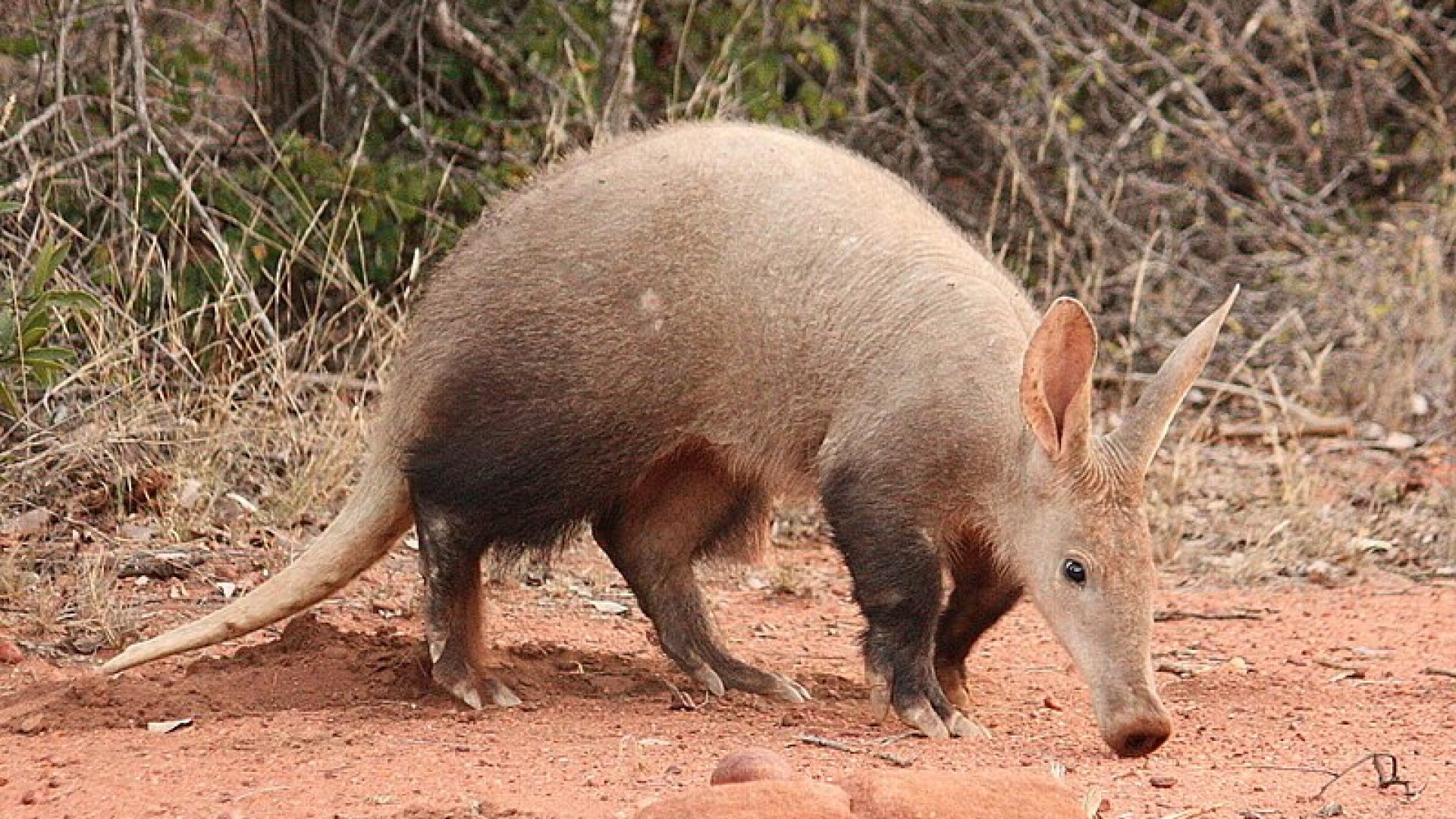
Aardvark
The Aardvark is an incredibly rarely seen animal. It is found on the savannahs of Africa, and generally lives well in and out of protected areas. It is quite a sizable aniimals, and has relatively high densities throughout its range (roughly 1 per square km in habitats that it is best suited to).
So why is it so rare to see this animal? They are one of the most exclusively nocturnal species that you can find. These are animals for which wildlife guides get excited.
The name, translated from Afrikaans means earth-pig. They are incredible diggers, and many of the burrows in the savannah are dug by them, who ever ends up using them.
The are insect eaters, and are well suited. Their claws are strong, allowing them to dig into the incredibly hard termite mounds, it has a long tongue of around 30cm, which they can direct down ant holes to get hold of their food. They have an incredible sense of smell and hearing to allow them to find the animals, and can shut their eyes and nose so as to avoid being attacked back.
Although rarely seen, there are places which have learnt how to watch them, giving you a great chance to see an animal few know about. Over recent decades, they have started appearing in zoos, with Colchester in the UK (should you visit, it is a species that needs patience, otherwise you are likely to just see a pile of aardvarks sleeping in their burrow.
It is at the top of animals I would like to see in the wild. Given, their range both in and out of reserves, I am hoping over time to build up plenty of places to see them out in the human world. Please get in touch if you are a farmer, who has these on your land.
Any of the savannah ecosystems on our wild places list will host these animals, however a great deal of luck will be needed to see them in the wild. However, we will add an special places we find where your odds are higher. For now, click here, if you want to visit a savannah ecosystem in the near future.
Red Colobus Group
The Red colobus group (genus Piliocolobus)
The red colobus group is one which has had a surprising number of new species discovered in recent decades. Being primates, they are usually fascinating and you can sit and watch them for lots of time. There are many groups that have been isolated in small fragments of forest, which makes conservation hard.
Little clear information is there on many of these species, perhaps unsurprisingly, given how long they managed to stay under the radar. I have attempted to include a video with each. Some are short clips of the animal, one is the search for a close to extinction (miss waldrons) and several is simple some information over images.
As with similar groups of animals, as the links for each of these species start arriving, they will be given an entire page of their own. Help this be required as soon as possible.
Bouviers red colobus monkey:
Not having been seen for 4 decades until 2015, they are restricted to 3 small areas (this map is the DRC) in purple highlighted. First described in 1887 it was considered a subspecies of Pennants colobus, but was reassessed as separate species in 2007.
In 2008 and 2016 it was assessed as critically endangered, and none have been seen in the wild since 1970. A few possible sightings in the 2000 were further south than previously known.
In 2019 the IUCN reclassified it as endangered because of “known populations in norther DRC”. It is still rarely sighted despite many surveys
Ugandan red colobus monkey:

Also known as the ashy red colobus, it was recognized as a separate species (up from being a subspecies of the western red colobus monkey) in 2001, though there are still plenty of experts who disagree with this change. It is found in 1 regions of Uganda (17,000 alone) and 4 regions of Tanzania. Possible it may be found in Rwanda, Burundi and the eastern Democratic Republic of the Congo. Males weigh around 10kg, with the females weighing 7kg.
As you will see, it is one of the possible subspecies of the Central Africa red colobus. Time will tell.
There are thought to be around 20,000 left in the wild, and are classed as endangered, though it is listed as having declined my 89% (presumably since 2001 when it was declared a separate species.
Central African red colobus monkey:

This species does not appear to be an individual species, rather a general name that many of the above species have at one time been grouped with. These include
- Foa’s red colobus
- Lang’s red colobus
- Oustalet’s red colobus
- Lomami red colobus
- Tana River red colobus
- Semliki red colobus
- Ugandan red colobus
Niger Delta red Colobus monkey: Found in Southern Nigeria, it was originally considered a subspecies of the western red colobus, then considered a subspecies of Pennants red colobus. There are only thought to be 50 left. Below is a 4 minute video from its habitat which shows it in the wild – makes me want to be there.
Pennants colobus monkey:
Preuss red colobus monkey:
Tholon (or Tshuapa) red colobus monkey:
Western red colobus monkey:
Zanzibar red colobus monkey: Found on the southern half of the main island of the Zanzibar archipelago (Unguja), it is also known as the Kirk redo colobus, after the discoverer. Classified as endangered in the mid 1990s, its population is still decreasing. It is believed to have been isolated when sea levels rose after the last ice age – however, as with other species trapped like this, they can evolve fast. Genetic analysis suggests a split 600,000 years ago.
The local word for it means poison monkey, due to its bad smell, this has lead to some targeting. 1600-3000 survive, with about half in protected areas.
Udzungwa red colobus monkey: (other names include the Uzungwa red colobus or Iringa red colobus) It is endemic to riverine and montane forest in the Udzungwa Mountains in Kilolo District of Iringa Region in Tanzania. It is threatened by habitat loss, though most of the land it is found on is protected (90% falls within the Udzungwa national park, I have seen one while visiting). Of course the problem with this, is that its range is not large, so it can never have a large population.
The current population is roughly 15,400. The IUCN ranks this species as endangered
Miss Waldrons red colobus monkey: Native to west Africa, it was previously considered a subspecies of the wester red colobus monkey. It has not been officially sighted since 1978 and was considered extinct in 2000, however, new evidence suggests that a very small number of these monkeys may be living in the southeast corner of Côte d’Ivoire. The IUCN Red List notes Miss Waldron’s red colobus as critically endangered.
High-canopy forests (rainforests) in Ghana and Côte d’Ivoire serve as the exclusive habitat of Miss Waldron’s red colobus. The monkey usually formed large family groups of 20 or more. It is a social and highly vocal animal, frequently communicating with others using loud calls, shrieks and chattering. It eats fruit seeds and canopy leaves, and is eaten in turn, by western chimpanzee leopard and python.
It was the first primate classed as extinct in the 21st century. However, evidence collected are highly compelling.
However, primatologist W. Scott McGraw from Ohio State University has been collecting evidence of the monkey’s continued existence during his expeditions to Côte d’Ivoire over the past several years:
- In 2000, McGraw was given a black monkey tail which DNA tests proved to be from a red colobus. The hunter who gave McGraw the tail claimed he had shot the monkey the previous year.
- In 2001, an Ivorian hunter gave McGraw a piece of reddish monkey skin also believed to have come from Miss Waldron’s red colobus.
- Also in 2001, McGraw received a photograph of what appeared to be an adult Miss Waldron’s red colobus which had been killed. Experts who have examined the photograph attest to its likely authenticity.
Presumably, a relict population of the monkey still is found in the Ehy Forest (also Ehi or Tanoé Forest) near the mouth of the Tano River into Ehy Lagoon, at the border between Côte d’Ivoire and Ghana. Miss Waldron’s Red Colobus is among the 25 “most wanted lost” species that are the focus of Re:wild’s “Search for Lost Species” initiative.
Whether a surviving population will be found, or if there are just a handful left, we will have to wait and see. The Below video is from this area, while it is in Hindi, it is worth watching with the subtitles on.

